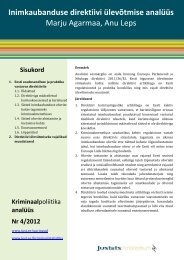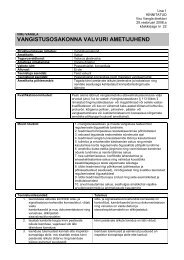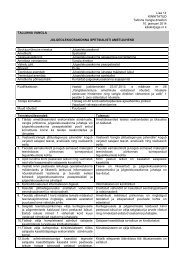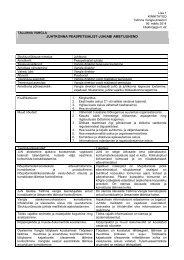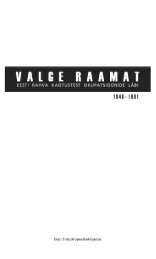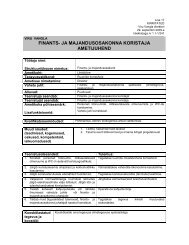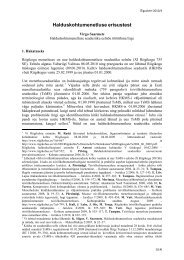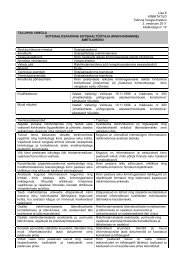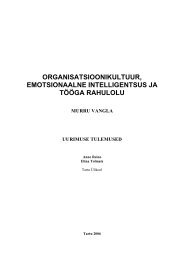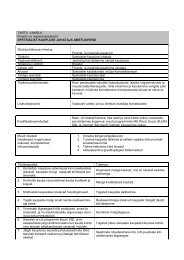11. Retsidiivsus Eestis - Justiitsministeerium
11. Retsidiivsus Eestis - Justiitsministeerium
11. Retsidiivsus Eestis - Justiitsministeerium
You also want an ePaper? Increase the reach of your titles
YUMPU automatically turns print PDFs into web optimized ePapers that Google loves.
RETSIDIIVSUS EESTIS 2010<br />
INTRODUCTION<br />
RETSIDIIVSUS EESTIS 2010<br />
INTRODUCTION<br />
For decades, the studies of recidivism or repeated commission of criminal<br />
offences have been one of the main research areas of criminology. Methods<br />
used to assess the level of recidivism can be divided in two categories.<br />
In retrospect studies the criminal offences committed earlier and their<br />
number is observed in case of a group of persons. One of the most common<br />
techniques is to assess the recidivism on the basis of data concerning people<br />
serving their punishment in prison. For example, in 1998, 33.6% of Estonian<br />
prisoners were punished for the first time (Saar et al., 2002, p. 331); in 2008,<br />
this indicator was 30% (Ahven and Jakobson, 2009, p. 104).<br />
Second type of repeated crime study, the succession study, regards recidivism<br />
as behaviour following certain event during a specific period of time.<br />
The study sample mostly includes convicted offenders or people released from<br />
prison in case of whom, for example, the commission of criminal offences<br />
is studied during the period of two years, the indicator of which could be<br />
either detention as a suspect, new conviction or re-imprisonment. Depending<br />
on the principles of putting together the sample, the recidivism rates also<br />
greatly differ: on one hand, the recidivism of people released from prison is<br />
higher than in case of convicted offenders’ population or some of its special<br />
population, e.g. people with pecuniary punishment; on the other hand, the<br />
proportion of people who are re-imprisoned during the period is smaller than<br />
the proportion of people detained as suspects in new criminal offences. This<br />
is caused both by the fact that some suspects never reach the court (not to<br />
mention the prison) and also by the length of proceedings: depending on the<br />
type of criminal offence and other circumstances this can differ very much and<br />
it is clear that, for example, within a year considerably more people have their<br />
first contact with the police than people who find their way back to prison by<br />
way of criminal proceedings.<br />
This study is the first succession study of recidivism in Estonia. This way,<br />
more versatile and extensive information is obtained than with retrospect<br />
studies. Among other things this also enables to assess the efficiency of<br />
criminal justice system upon reducing recidivism; for example, if we were to<br />
compare the recidivism of people released prematurely and people released<br />
after serving their sentence and it becomes evident that in case of the first<br />
group the proportion of people who have committed new criminal offences is<br />
bigger, then this may refer both to the inefficiency of continued care system<br />
and decision makers’ wrong choices. The influence of underestimating the<br />
recidivism risk on the safety of society may be clearly perceptible in such cases.<br />
Recidivism assessments cannot be based on the gut feeling. When<br />
approaching this topic emotionally there is a tendency to overestimate the<br />
risk of repeated commission of criminal offences. This leads to a big proportion<br />
of people punished pursuant to criminal procedure to the population and<br />
a high number of prisoners.<br />
Naturally, it is dangerous to underestimate recidivism as well: if a person<br />
who has just been released from prison kills a human being, there is definitely<br />
a reason to ask why this person is at large and what did this person think who<br />
allowed him/her to be released.<br />
During the last decades, the questions where one or the other line should<br />
be drawn have been discussed on a continuous basis. At the same time we<br />
have had to rely first of all on the experience of other countries because we<br />
ourselves have not conducted almost any studies. Often, relying on the experience<br />
of developed countries justifies itself well, as the factors leading to criminal<br />
behaviour are universal in many aspects and there is no country where<br />
these factors could have been liquidated, however, there are countries which<br />
have been more successful in this respect than the others.<br />
Circumstances which predict the continuation of repeated commission of<br />
criminal offences in the future are similar to the ones which are related to the<br />
commission of first criminal offences (Zamble and Quinsey 1997, p. 2). In<br />
most cases the criminal justice system cannot change these factors. However,<br />
it is being strived to find solutions which would not intensify these factors; for<br />
example, it has been understood that in the camp prisons or dormitory-type<br />
prisons criminal behaviour increases rather than decreases.<br />
The situations repeatedly occur in criminal proceedings when a prosecutor<br />
and a judge have to estimate what is the best way to deal with a criminal<br />
offender: whether the offender has to be arrested, imposed actual prison<br />
sentence, prematurely released, etc. No matter how much information the<br />
body conducting proceedings has, the assessment concerning a person’s future<br />
behaviour can still be only an assumption. This, on which the assumptions of<br />
bodies conducting proceedings are based, is analyzed in the second part of<br />
this study.<br />
In addition to pointing out the recidivism indicators and the analysis of<br />
recidivism risk, the analysis of how prisoners cope after release from prison<br />
can also be found from the study.<br />
In the following chapters only part of the analysis is presented in English. The<br />
sections about the evaluation of recidivism risk by judges and prosecutors are<br />
available on our web-page: www.just.ee/recidivism.<br />
156<br />
157



